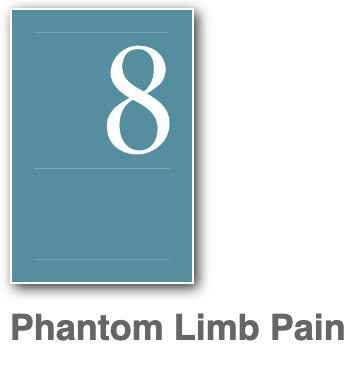Amputation / Phantom Pain
Amputation – Neuroma and Phantom Pain
What is amputation pain due to nerve injury?
When a body part is removed, nerves are cut. The cut ends of the nerves left behind
are still alive. They usually sprout, and with nowhere to go, form “bulbs” of raw nerve
ends called neuromas. Neuromas may be painful to the touch, and cause unpleasant
electric, shock-like sensations when bumped. They can also send constant pain signals
to the brain. Patients describe the feeling as burning, itching, numb and deep aching
pains. These nerve ends can also get caught up in scar tissue, causing them to be
tethered and “pulled on” when the residual body part is moved. This increases pain,
and prevents patients from being able to do certain activities.
Phantom pain is the feeling of the missing body part. The brain can still truly believe
that the missing part is still there, and is “on fire”, as a result of the raw ends of the cut
nerves sending abnormal sensation signals.
Who can get amputation pain?
Any removed tissue can lead to amputation pain – both neuroma and phantom pain.
This can happen no matter where or how much tissue is missing. A fingertip, a leg, a
breast – any tissue that was lost during a traumatic injury, or from an operation.
How is amputation pain diagnosed?
Doctors diagnose amputation pain in three steps:
1. A history of pain in residual tissue next to an amputation.
a. The pain can usually be made worse by touching the area, moving it,
or wearing a prosthesis.
b. The pain is often sharp, burning, and/or stabbing, but can also be dull
and deep.
c. Bumping or hitting the painful spot can send electric shocks up or
down the limb.
2. A physical exam
a. The area of pain usually corresponds to known pathways of major
nerves.
b. Causes other than injured nerves are considered – these may be
inflammation or infection of the tissues, extra bone growth, or fluid
build-up.
3. Testing
a. To confirm that an injured nerve(s) is the cause of pain, a local
anesthetic (nerve block) can be performed. This is a small “shot” of
numbing medicine performed in the office. If the pain goes away
temporarily, then it is highly likely that it is from an injured nerve.
b. Xrays may help to determine extra bone growth that can be painful
(known as heterotopic ossification, HO). This growth can be surgically
removed.
c. MRIs can diagnose scar tissue, inflammation and fluid build up as a
cause for the pain, which can then be treated.
Can amputation pain be treated surgically?
Surgery is highly successful in eliminating or greatly reducing amputation pain.
Depending on the cause, different operations could be recommended:
Neuroma and phantom nerve pain – segments of the injured nerves can
be cut out, thereby stopping the pain signals from reaching the brain.
Heterotopic ossification (HO) – just as the cut nerves can sprout,
excess bone can grow off of the cut ends of the bone and cause pain.
This bone can be removed if found to be the cause of the pain.
Fluid (bursa) or scar tissue – surgery can also be helpful for these
issues.
Are there new techniques for improving the outcomes from surgery?
Surgeons at Neuropax use the two newest procedures – RPNI (regenerative peripheral
nerve interface, muscle/skin grafts on the nerve ends) and TMR (targeted muscle
reinnervation, nerve transfers) in efforts to improve the outcomes of nerve surgery for
chronic pain. These techniques have been shown to significantly decrease the chances
for
pain.




















